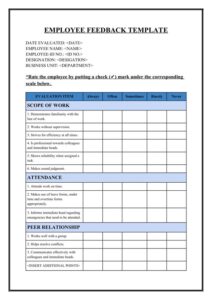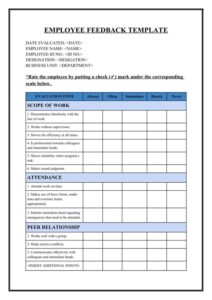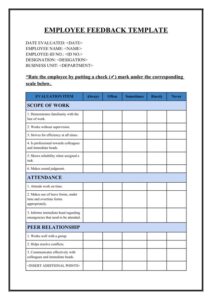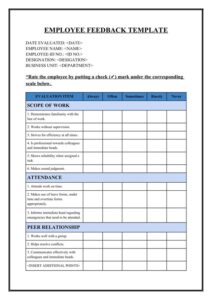Ever wondered how to get a truly comprehensive view of an employee’s performance and development needs? Traditional top-down performance reviews often fall short, providing only one perspective. That’s where a 360-degree evaluation comes in, offering a holistic look by gathering feedback from peers, direct reports, supervisors, and even the employee themselves. It’s a powerful tool for fostering growth, identifying blind spots, and building a more effective, collaborative workplace culture.
But creating a robust and effective 360-degree evaluation can feel like a daunting task. What questions should you ask? How do you ensure the feedback is constructive and actionable? The good news is, you don’t have to start from scratch. A well-designed 360 degree employee evaluation survey template provides a solid foundation, streamlining the process and ensuring you capture all the essential insights needed to drive individual and team improvement.
The Core Components of an Effective 360 Degree Evaluation
When crafting or selecting a 360 degree employee evaluation survey template, it’s crucial to focus on questions that elicit meaningful and actionable feedback. The goal isn’t just to rate performance, but to understand how an individual interacts within the team, demonstrates leadership, manages tasks, and contributes to the overall success of the organization. A strong template encourages open and honest responses, guiding raters to provide specific examples rather than vague statements.
Think about the various competencies that are vital for success in your organization. These often include communication skills, teamwork, problem-solving, adaptability, leadership potential, and commitment to company values. Each question should be designed to shed light on how an employee performs in these areas from multiple angles, allowing for a comparative analysis of self-perception versus the perceptions of others.
Key Areas to Cover in Your Template
To ensure your 360 degree employee evaluation survey template captures the full picture, consider including sections dedicated to specific competency groups. This structure helps organize feedback and makes it easier to identify trends and areas for development. Remember to balance quantitative ratings with qualitative comment boxes, as the latter often provide the richest insights.
- Communication: How well does the employee listen, convey ideas, and facilitate understanding?
- Teamwork & Collaboration: How effectively do they work with others, share knowledge, and support team goals?
- Leadership & Initiative: Do they inspire others, take ownership, and proactively address challenges? (Applicable even for non-managerial roles).
- Problem-Solving & Decision-Making: How analytical and effective are they in resolving issues and making choices?
- Adaptability & Learning: How well do they embrace change, learn new skills, and apply feedback?
- Job Knowledge & Technical Skills: Do they possess the necessary expertise and apply it effectively?
- Overall Effectiveness & Impact: A holistic view of their contribution to the team and organization.
By including these key areas, your 360 degree employee evaluation survey template becomes a comprehensive tool for development. It provides a structured approach to gathering diverse feedback, highlighting both strengths to leverage and opportunities for growth. Tailoring these sections with specific questions relevant to your company culture and individual roles will further enhance its effectiveness.
Implementing and Maximizing Your 360 Degree Employee Evaluation Survey Template
Having a great 360 degree employee evaluation survey template is just the first step. The true value comes from how you implement the process and, crucially, how you use the feedback. Before distributing the template, clearly communicate the purpose of the evaluation to all participants. Emphasize that it’s a developmental tool, not a disciplinary one, and that the goal is to help employees grow and improve, fostering a culture of continuous learning.
Confidentiality is paramount. Assure participants that their individual responses will be anonymous and aggregated, reducing inhibitions and encouraging honest feedback. This trust is essential for the integrity of the process. Once the feedback is collected, the next critical step is to present it to the employee in a constructive manner, often facilitated by a manager or an HR professional.
The feedback session should focus on understanding the data, identifying patterns, and collaboratively developing an action plan. This isn’t about pointing fingers but about recognizing areas where the employee’s self-perception might differ from how others perceive them, or where consistent themes emerge across multiple raters. The output of the 360 review should directly feed into individual development plans.
- Communicate Clearly: Explain the ‘why’ and ‘how’ to all participants.
- Ensure Anonymity: Protect individual responses to encourage candor.
- Train Raters: Provide guidance on giving constructive, specific feedback.
- Facilitate Feedback Sessions: Help employees interpret results and create action plans.
- Follow Up: Periodically check in on progress and offer support for development goals.
Remember, a 360-degree evaluation is not a one-time event but part of an ongoing commitment to employee development. By effectively utilizing your 360 degree employee evaluation survey template within a supportive framework, you empower individuals to take ownership of their growth, strengthen team dynamics, and ultimately contribute to a more thriving and successful organization.
Embracing the insights gained from a well-executed 360-degree evaluation can truly transform your approach to performance management. It moves beyond traditional appraisals, providing a richer, multi-faceted understanding of an employee’s strengths and areas for improvement. This comprehensive feedback fosters a culture of self-awareness and continuous development, benefiting not just the individual, but also their team and the entire company.
When employees feel supported in their growth and understand how their contributions are perceived by those around them, engagement and productivity naturally increase. By leveraging a thoughtfully designed template and a supportive implementation process, you’re investing in your most valuable asset: your people, helping them to reach their full potential and drive organizational success.



